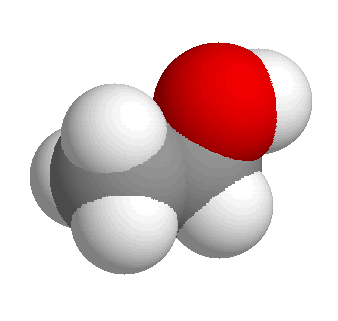 |
 |
Kleine Moleküle: |
| Äthanol in raumfüllender Darstellung | Drahtmodell - die Elektronenwolke ist durch Punkte angedeutet |
Alkohole (Alkanole) sind aliphatische Kohlenwasserstoffverbindungen, bei denen eine oder mehrere Hydroxylgruppen (-OH) direkt am Kohlenstoff gebunden sind.
H | H - C - OH | H |
H | H - C - OH | H - C - H | H |
H | H - C - OH | H - C - H | H - C - H | H |
H | H - C - OH | H - C - CH3 | H - C - H | H |
| Methanol | Äthanol | Propanol | Isobutanol |
Äthanol, Propanol.
Enthält das Molekül nur eine -OH - Gruppe, spricht man von einwertigen Alkoholen, enthält sie zwei, von zweiwertigen, drei von dreiwertigen oder mehrere von mehrwertigen Alkoholen.
H | H - C - OH | H - C - OH | H |
H | H - C - OH | H - C - OH | H - C - OH | H |
| Glycol | Glycerin |
Glycerin
H | H - C - OH | H - C - OH | HO - C - H | H - C - OH | H - C - OH | H - C - OH | H |
H | H - C - OH | H - C - OH | HO - C - H | HO - C - H | H - C - OH | H - C - OH | H |
||
| Sorbit = Sorbitol | Mannit = Mannitol | ||
Wichtig ist noch die Einteilung in primäre, sekundäre und tertiäre Alkohole, die von der Zahl der H-Atome, die am gleichen C-Atom wie die -OH-Gruppe sitzen, abhängt.
H | R1 - C - OH | H |
R2 | R1 - C - OH | H |
R2 | R1 - C - OH | R3 |
| primärer | sekundärer | tertiärer |
| Alkohol | ||
| Galerie: Struktur und Daten einiger Alkanole |
|
|